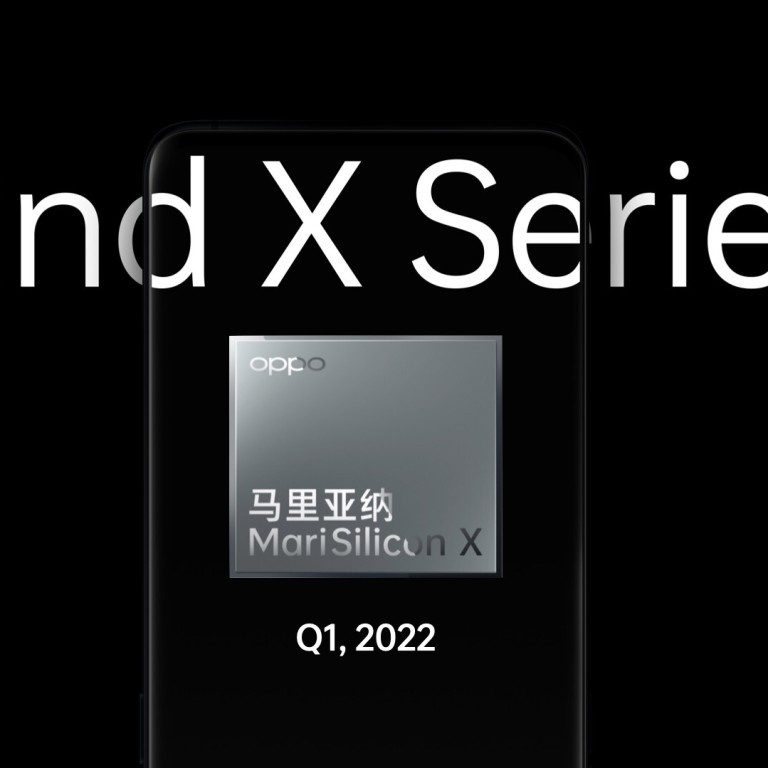
Smartphone giant Oppo launches its first chip, joining Chinese rivals Huawei and Xiaomi in semiconductor race
- The MariSilicon X is designed for faster and better image processing, Oppo said, and it will launch with new Find X series phones in Q1 2022
- The company also unveiled its new AR eyewear called Air Glass, which it hopes will be a third screen alongside smartphones and smartwatches
Called MariSilicon X, the new chipset is a neural processing unit (NPU) – designed to implement machine learning algorithms – built using the 6-nanometre node process of Taiwan Semiconductor Manufacturing Co (TSMC). Oppo said the chip enables faster image and video processing with less battery drain. The chip was unveiled at the company’s InnoDay event on Tuesday.
“MariSilicon X is only a small step for Oppo,” Oppo founder and CEO Chen Mingyong said during the launch event. “We won’t stop and we will continue to invest resources into chips, with a team of thousands of people. It will be a long journey, with many challenges ahead, but we will persevere.”
After conquering India, Realme founder details plans for growth in China
The first phones to feature the new chip will be Oppo’s Find X series handsets, which are slated to launch in the first quarter of 2022. Compared with the Find X3 Pro, the company’s current flagship device, Oppo said the MariSilicon X will enable that phone’s successors to take photos with four times greater dynamic range, produce clearer videos in dark environments, and process images 20 times faster.
Oppo is now one of multiple Chinese smartphone companies seeking to develop its own chips in the wake of US sanctions on Huawei that have stunted the growth of that firm’s chip unit HiSilicon. Since the telecoms equipment maker was put on a trade blacklist in 2019, Beijing has accelerated efforts to grow more domestic chip makers, both in design and manufacturing.
Huawei’s Kirin processors once competed with high-end chipsets from the likes of Samsung Electronics and Qualcomm. But the captive chip design house, which had to outsource the manufacturing of its silicon, was unable to keep up after being cut off from using US technology to make advanced chips.
As Chinese fabrication plants are still unable to manufacture chips using anything more advanced than the 14-nm node process, Chinese chip designers must rely on fabs run by TSMC and Samsung to produce smaller semiconductors.
Xiaomi released its first in-house chipset, the Surge S1, in 2017. Since then, the smartphone maker has faced “huge difficulties” in designing another chipset, founder and CEO Lei Jun said last year, but its efforts are “still ongoing”. Vivo also unveiled its own self-designed chip in September.
During the InnoDay event, Oppo CEO Chen noted the importance of companies controlling more of the technology used in their products.
China pauses efforts on advanced chips as attention turns to mature nodes
“A tech company without core technology is one that has no future,” he said. “A flagship product without fundamental technology may be just a mansion built in the air.”
Chip design has become a major product differentiator in the electronics market in recent years, with tech giants like Apple, Samsung and Google touting exclusive features only available on their hardware. Last year, Apple shocked the industry with the high performance of its ARM-based M1 chip that it started using in laptop and desktop computers, a market dominated by Intel’s x86-based chips. The M1 is fabricated by TSMC.
The ongoing global chip shortage, resulting from disrupted supply chains during the pandemic, has also favoured companies that are able to produce at scale. This has given Apple, the world’s largest smartphone brand, and Samsung, which can manufacture its own chips, an edge over smaller rivals in keeping their newest devices in stock.

In addition to the new chipset, Oppo unveiled a new pair of smart glasses at the InnoDay event, which the company said would also launch in the first quarter of next year. Liu Chang, dean of Oppo’s Research Institute, said smart glasses could become users’ third screen, after smartphones and smartwatches.
Like other augmented reality eyewear, Oppo’s Air Glass uses a micro projector and LED display to show information like navigation maps and voice-to-text translations over real-world environments.

